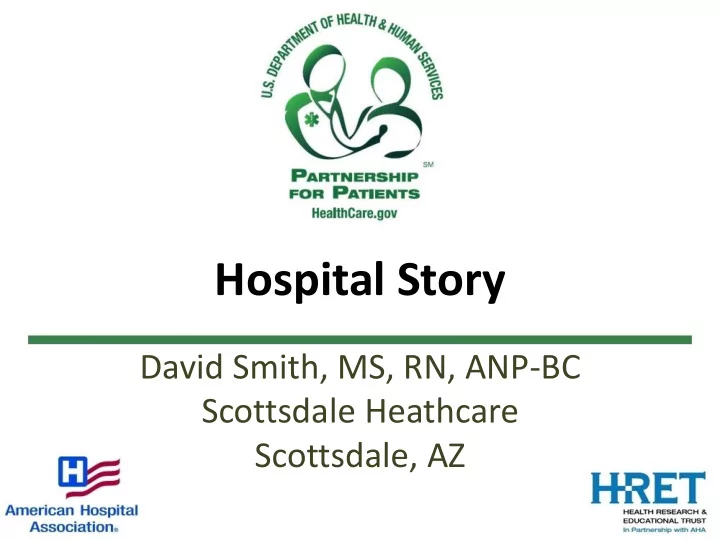

Hospital Story David Smith, MS, RN, ANP-BC Scottsdale Heathcare Scottsdale, AZ
Objectives and About Us • Scottsdale Healthcare is a community health system located in Scottsdale, Arizona composed of 3 acute care hospitals and comprehensive ambulatory services. • Magnet status as a system. • Objectives – List two factors used to determine the composition of the multidisciplinary team. – List a strategy used to overcome cultural barriers. 2
Team Formation • Team leadership provided by three nurses who were participating in our Clinical Scholars Program (an EBP training fellowship for RNs). • Additional team members selected from the ICU nursing staff, registered dietitian, materials management staff, nursing leadership, Quality Enhancement Services staff, and the Director of Nursing Research. 3
AIM and Measure Selection • Goal: Reduce unit-acquired pressure ulcer rate to below the NDNQI mean (based on unit type and hospital size). • Measure was selected because NDNQI is the primary database used at SHC to benchmark nurse-sensitive quality outcomes. • This ICU had been above the mean for most quarters for more than a year. 4
Tests of Change • This practice improvement program was developed as part of a evidence-based practice fellowship for RNs. – Review of literature. – Comparison of evidence-based best practices with typical practice in the ICU at that time. – Staff initiated monthly prevalence studies (NDNQI is quarterly). – Interventions expanded as a deeper understanding of the pressure ulcer literature developed. – Eventually expanded to all ICUs in the system after successful tests of change in a single unit. 5
Barriers, and How We Resolved those Barriers • Culture and resistance to change were the biggest barriers. – Project leaders worked to develop a strong sense of peer-to-peer responsibility. – Use of “wound warriors” for all shifts. – Monthly feedback to staff at unit meetings, one on ones, and posters placed in break room. – Making data real and adding the human factor. 6
Outcomes
Advice for Fellows • It takes a team . • Enthusiastic leadership is vital. • Get staff personally involved – bad outcomes are a reflection of our practice – Take Ownership. • Even simple data requires translation . • Celebrate victories no matter how small. • Do not settle for less than what you had planned. • A deep dive into the literature is vital in determining best practices. 8
Wrap Up and Next Steps • Summary: Development and implementation of an evidence-based pressure ulcer prevent protocol by a multidisciplinary team resulted in a statistically significant reduction in HAPU formation throughout our system. • Next steps: Examining the impact of increased use of technology to ensure a bundle of critical nursing behaviors (including hourly rounding and bedside handoffs) on patient falls. • Questions? 9
Recommend
More recommend